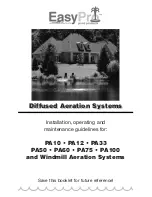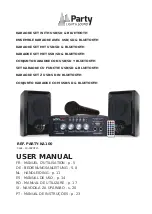
Sx80PI T
w
o
-W
ay Speaker System W
ith T
ransformer
Sx80PI Two-Way Speaker System With Transformer
2
but protects the tweeter from long-term
power extremes that would normally destroy
the tweeter.
Enclosure Construction
The Sx80PI enclosure is contructed of very-
durable High-impact polystyrene that is hard
to dent, scratch, or break. This enclosure
allows for molded in attachment points for
the optional Sx80MB mounting bracket,
Sx80SM stand mount, or for use with a
OmniMount
®
Series 75 mounting system.
The enclosure is paintable to match any de-
cor. It is recommended, however, that a small
area should be tested with the desired paint
in order to ensure that there are no adverse
effects and that the paint has sufficient ad-
hesion. Care should be taken not to get paint
onto the woofer cone or into the horn throat.
Frequency Response
The combination of a 203-mm (8-inch)
woofer, a wide-bandwidth high-frequency
driver and an equalized crossover results in
the wide and smooth overall response shown
in Figure 1a. This response was measured
at 1 meter (3.281 feet), using a 2.83-volt swept
sine-wave input in a full-space anechoic cham-
ber using the internal passive crossover. No
external equalization was used.
Figure 1a also shows the half-space measure-
ment of the Sx80PI loudspeaker. This curve
gives an indication of how the system will
respond when mounted on a wall, which is a
likely application. This response was also
measured at 1 meter (3.281 feet), using a
2.83-volt swept sine-wave input using the
internal passive crossover. No external
equalization was used.
Figure 1b shows the full and half space
measurments with optional port covers in-
stalled.
Port Covers
The two ports, between the horn and the
woofer, may be "sealed" in order to add fur-
ther weather protection to the system. These
optional plastic port covers are included with
the system for use in situations where in-
creased weather resistance is needed. This
will help prevent any moisture from wicking
through the foam- and mesh-backed grille
and accumulating inside the enclosure un-
der extreme weather conditions. The op-
tional port covers and instructions are sup-
plied with each system. It should be noted,
however, that once the port covers are in-
stalled, the frequency response will change
to that shown in Figure 1b.
Connections
The Sx80PI is equipped with barrier strip
connectors with a cover. Care should be
taken to ensure that the correct polarity is
observed when connecting the Sx80PI. The
barrier strip is marked with + for positive
and - for negative.
Constant-Directivity Speaker System
The crossover frequency and speaker com-
ponent geometries have been selected so that
the directional characteristics of the woofer
and constant-directivity high-frequency horn
match at the crossover frequency to create a
special system type, the constant-directivity
system. At higher frequencies the horizon-
tal coverage pattern remains constant and the
vertical pattern smoothly transitions to a 90°
angle above 5,000 Hz. Response within the
90° x 65° rated coverage angle is uniform,
which means dependable audience coverage
without “hot spots” or dead zones at certain
frequencies. The 90° x 65° dispersion char-
acteristic also helps avoid early reflections
from nearby floor or side-wall surfaces which
could degrade performance. The controlled
directivity of the high- and low-frequency
transducers also eliminates response irregu-
larities caused by diffraction off nearby en-
closure edges and, in combination with an
essentially flat on-axis frequency response,
produces a total acoustic power output that
is uniform with frequency.
Directivity
A unique feature of the Sx80PI is the con-
stant-directivity dispersion provided by the
90° x 65° horn. The polar response of the
system at selected one-third-octave band-
widths is shown in Figure 2. These polar
responses were measured in a full-space
anechoic environment at 6.1 meters (20 feet)
using one-third-octave pink-noise inputs.
The frequencies selected are fully represen-
tative of the polar response of the system.
Beamwidth of the system utilizing the com-
plete one-third-octave polar data is shown
in Figure 3. Directivity factor, R
Θ
,
and di-
rectivity index, D
i
, are plotted in Figure 4.
Power-Handling Capacity
Electro-Voice components and systems are
manufactured to exacting standards, ensur-
ing they will hold up, not only through the
most rigorous of power tests, but also
through continued use in arduous, real-life
conditions. The EIA Loudspeaker Power
Rating Full Range (ANSI/EIA RS-426-A
1980) uses a noise spectrum which mimics
typical music and tests the thermal and me-
chanical capabilities of the components.
Electro-Voice will support relevant addi-
tional standards as and when they become
available. Extreme, in-house power tests,
which push the performance boundaries of
the woofers, are also performed and passed
to ensure years of trouble-free service.
Specifically, the Sx80PI passes ANSI/EIA
RS-426-A 1980 with the following values:
R
SR
= 6.21 ohms (1.15 x R
E
)
R
E
= woofer DCR = 5.4
P
E(MAX)
= 175 watts
Test voltage = 32.97 volts rms,
65.93 volts peak (+6dB)
The “peak” power-handling capacity of a
woofer is determined by the peak test volt-
age amount. For the Sx80PI, a 65.93-volt
peak test voltage translates into 700-watts
short-term peak power-handling capacity.
This is the equivalent of four times the “av-
erage” power-handling capacity, and is a
peak that can be sustained for only a few mil-
liseconds. However, this sort of short dura-
tion peak is very typical in speech and mu-
sic. Provided the amplifier can reproduce
the signal accurately, without clipping, the
woofer will also perform accurately and re-
liably, even at these levels.
Service
In the unlikely event the Sx80PI requires ser-
vice, the woofer can be removed from the
front. The high-frequency driver can be re-
moved by separating the front and the rear
halves of the enclosure and removing the bolt
that attaches the driver to the rear. A service
data sheet is available from Electro-Voice.






























